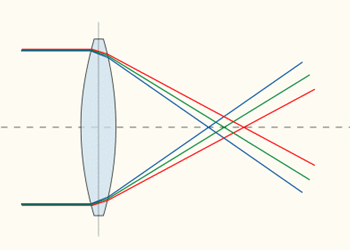 Spherical aberration
Spherical aberration
The aberrations are categorized into various types. The two main types of aberration are:
(1) Spherical aberration
(2) Chromatic aberration
By combining lenses in certain ways, aberrations can be minimized.
Spherical aberration:
It results from light that passes through the edges of a lens focusing at a slightly different place from where light passing
through the center of the lens focuses. Thus, a blurred image is formed. This can be rectified by covering the edges of a lens,
as with a diaphragm in a camera. A simple method to reduce spherical aberration is to use a stop before and in front of the lens.
However, this method reduces the intensity of the image as most of the light is cut off. Spherical aberration is efficiently
corrected by the usage of a combination of concave and convex lenses.
 Chromatic aberrations
Chromatic aberrations
Chromatic aberration:
It is the result of light of different colors having different speeds and hence different refraction in the lens. In a simple
lens (as in a prism), red light and blue light do not come to focus in the same place. The chromatic aberration is corrected by
constructing what is known as an achromatic combination of lenses or an achromatic lens. Since a convex lens and a concave
lens produce chromatic aberrations in opposite sense, it is possible to compensate the aberration produced by one lens by
that produced by the other.